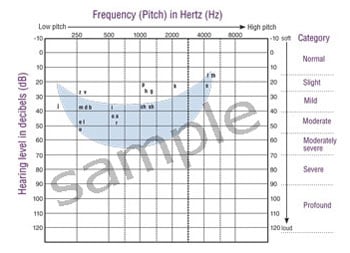The Audiogram
The audiogram is a graph showing the results of a pure-tone hearing test. It will show how loud sounds need to be at different frequencies for you to hear them. The audiogram shows the type, degree, and configuration of hearing loss.

When you hear a sound during a hearing test, you raise your hand or push a button. The audiologist will make a note of how loud the sound was at each frequency. At the end of testing, the audiogram will show what you heard.
Pitch or Frequency
Each line that runs from left to right shows a frequency in Hertz, or Hz. The lowest pitches are on the left side and the highest pitches are on the right side. The frequencies tested are 125 Hz, 250 Hz, 500 Hz, 1000 Hz, 2000 Hz, 3000Hz, 4000 Hz, and 8000 Hz.
Examples of "low-frequency" sounds are a rumble of thunder, a tuba, and sounds like the "oo" in "who."
Examples of "high-frequency" sounds are a bird chirping, a whistle, and the "s" sound in "sun."
Loudness or Intensity
Each line from top to bottom shows how loud the sound is in decibels, or dB. Lines at the top of the chart are for soft sounds. Lines at the bottom of the chart are for loud sounds.
Examples of soft sounds are a clock ticking, a person whispering, and leaves rustling.
Examples of loud sounds are a lawnmower, a car horn, and a rock concert.
The audiogram shows the pattern of your hearing loss. It also shows how severe it is, called the degree of hearing loss. For example, your hearing might be normal for low pitches but not for high pitches. In this case, you might hear speech, but it would not sound clear. If you have hearing loss at all pitches, you might have problems hearing any speech.
The audiologist marks what you hear in your right ear with a red O. What you hear in your left ear gets a blue X. If the Xs and Os are at the top of the graph, your hearing is normal. You have a hearing loss if the Xs and Os are farther down the graph.
To find an audiologist near you, visit ProFind.










